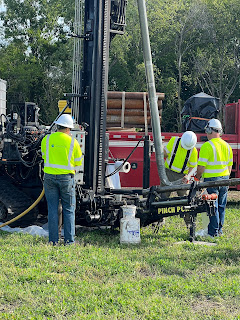2-DAY WORKSHOP
|
Title: |
Managing
the Complexities and Uncertainties of Soil Sequences: |
|
Date: |
Tuesday
and Wednesday, September 20-21, 2022 |
|
Location: |
Kane County Cougars Baseball Stadium – Conference Facility and Owners Suite with a private offsite drilling location. |
|
Instructors: |
•
Dan Kelleher, PG, CIPM, Hydrogeologist and Principal, Midwest
GeoSciences Group • Tim
Kemmis, PG, PhD, Hydrogeologist, Midwest GeoSciences Group |
What did we find in this soil boring?
Why was it so exquisite?
The course instructors have drilled
numerous continuous soil borings in the region for the past 20 years. We've
found a predictable consistency in the geologic framework beneath numerous
cities and towns where these stratigraphic formations and members are mapped.
However recently, we've discovered an entirely new and older sedimentary
sequence that has not been regionally mapped. The buried sequence allows an
unmatched opportunity to teach both the principles of depositional environments
and secondary weathering in northeastern Illinois where we didn't know
previously existed.
[Not only did the new sedimentary sequence get us excited, but we recognize how
it can applied to many different glacial deposits and sedimentary sequences far
beyond the local geologic framework]
Wisconsin-Age Sediments
The drilling location for this course in Geneva, Illinois is within the mapped
area of the Yorkville Member of the Lemont Formation near the DuPage - Kane
County border. Four facies of the Yorkville Member are expected to be present
in the boring: an ice-marginal facies and three subglacial facies. Below the Yorkville
Member is the Batestown Member which can be variable in depositional
environments and the resulting sedimentary properties.
Sorted outwash sediments of the Henry Formation and/or the Equality Formation
may occur within the Yorkville Member or Batestown Member. One of the most
interesting discoveries is when sorted sediments are present and then to
recognize its stratigraphic position and context. Without stratigraphic
control/context, understanding the relationships between borings (where the
sorted sediments are present) is virtually 'mission impossible'. But with
stratigraphic context, it gives tremendous certainty and we can correlate
buried sands without much question.
Pre-Wisconsin-Age Sediments
This boring confirmed a buried "pocket" of pre-Wisconsin-Age
sediments in the area. We ran Carbon-14 dating tests of the buried topsoil and
confirmed it was pre-Wisconsin-Age and we assigned it to the Farmdale GeoSol.
Under the buried A-Horizon topsoil is a thick oxidized and unleached (OU)
weathering zone. The sedimentary sequence included both subglacial and
resedimented diamictons (glacial till) along with intervals of sorted
sediments.
Not only is the buried "pocket" geologically interesting and an
important discovery for regional mapping, but this single soil borings revealed
the spectrum of attributes that can be applied to most glacial sequences
anywhere.
In this one boring, we
- observed each of the major glacial depositional environments
- observed each of the major outwash depositional environment
- built a stratigraphic model based on depositional history
- gave geologic context to buried sand and gravel intervals
- and determined if they tend to be isolated lenses
- and determined if they tend to be laterally continuous
- observed two weathering zone profiles
- observed two A-Horizon Soils, one modern and one ancient
- learned how ground water moves through the holistic hydrogeologic system.
This was a historic opportunity to more than
witness a geologic discovery. This iwas historic opportunity to learn about
applying geologic principles to professional work. There are not many chances
like this where we can synthesize the geology in a way it can be applied to so
many different other areas.




.jpeg)











No comments:
Post a Comment